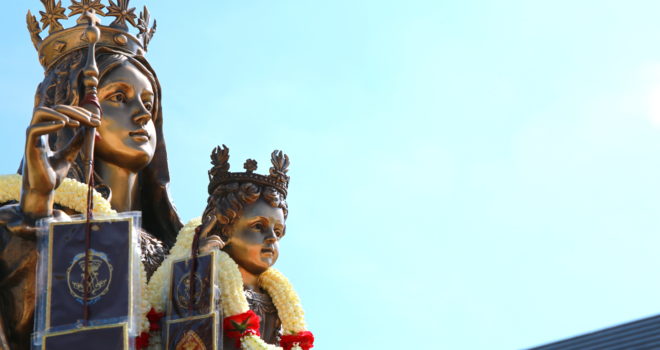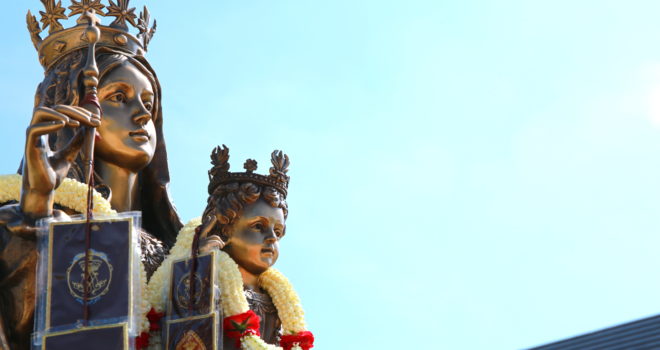Baptized in Jesus Christ
Do you not know that all of us who have been baptized into Christ Jesus were baptized into his death? Therefore we have been buried with him by baptism into death, so that, just as Christ was raised from the dead by the glory of the Father, so we too might walk in newness of life.
Romans 6:3-4
The Weight of Glory
During the pontificate of Pope St. John Paul II, a reporter asked him which of the papal titles were most significant to him. Many of us are not aware, or have become accustomed to the centuries-old titles given to the pope, such as the Bishop of Rome, the Vicar of Christ, Successor of Saint Peter, Supreme Pontiff of the Universal Church, and Sovereign of the State of Vatican City, to name just five. In addition, there are the titles of direct address, such as “Your Holiness,” or “Holy Father.” Imagine being addressed by such titles all throughout the day! The reporter’s question was a good one. Which of all these titles meant the most to the John Paul II? In his usual teaching style, Pope St. John Paul II gave several answers in gradual importance. He explained how the titles summarize our Faith, and then how the titles humble him and remind him of his vocation in the Church, but then he reached the answer that truly disclosed his heart. John Paul II answered the casual question with a profound answer. It is an answer that should shake us and remind us of our dignity as believers. Our beloved saintly pope responded that his favored title was the one that bore the greatest weight. It was the title, “Christian.” For John Paul II, the most cherished of all his titles was “Christian.” It is the foundation of everything else and the one that gives meaning to all else. It is the basis, the inspiration, and the declaration of everything else. I am a Christian. I am baptized into Jesus Christ. I am a child of God. I am anointed. I am “a small Christ.”
Through Baptism the Christian is sacramentally assimilated to Jesus, who in his own Baptism anticipates his death and resurrection. The Christian must enter into this mystery of humble self-abasement and repentance, go down into the water with Jesus in order to rise with him, be reborn of water and the Spirit so as to become the Father’s beloved son in the Son and “walk in newness of life.”—Catechism of the Catholic Church, 537
The title Christian, therefore, is both our greatest boast of God’s grace and our most pressing challenge. In Baptism, we were made children of God and members of Christ’s own Body. We were made Christians, and throughout our lives we have to work and suffer to live up to this upward calling. We pray, with St. Paul, to press on every day toward the goal for the prize of the heavenly call.
Not that I have already obtained this or have already reached the goal; but I press on to make it my own, because Christ Jesus has made me his own. Beloved, I do not consider that I have made it my own; but this one thing I do: forgetting what lies behind and straining forward to what lies ahead, I press on toward the goal for the prize of the heavenly call of God in Christ Jesus. —Philippians 3:12–14
The early believers of our Faith, however, did not feel worthy of the title Christian. Since it implied a person being “a small Christ,” they avoided the title. The earliest believers of the Lord Jesus were simply identified as “followers of the Way.” The expression indicated that believers understood their call to live and continue the Way of the Lord Jesus. Over time, however, unbelievers who witnessed the love and selfless service of our forefathers and foremothers began to call them Christians. And so, it was those outside of the Faith who began to call us Christians, since they saw something of the Lord Jesus in the followers of the Way (cf. Acts 11:26). The title eventually stuck and we now call ourselves Christian. We should never forget, however, the meaning and demands that come with such a name and the humility of our forebears in approaching such a name. St. Paul understood the gravity of what it meant to be a Christian. He refers to “an eternal weight of glory” that will be given to us in Heaven and for which we yearn and readily suffer for the sake of the gospel in this life.
So we do not lose heart. Even though our outer nature is wasting away, our inner nature is being renewed day by day. For this slight momentary affliction is preparing us for an eternal weight of glory beyond all measure, because we look not at what can be seen but at what cannot be seen; for what can be seen is temporary, but what cannot be seen is eternal. —2 Corinthians 4:16–18
Baptism is an eternal weight of glory. By Baptism, we became members of Christ’s own Body. It is how we can dare to call ourselves Christians. We now live, move, and have our being in Jesus Christ. As such, we draw close to Him, allow His grace to transform us, we seek to faithfully follow His way, to continue His work, to love as He loved, and to share eternal glory with Him in eternity (see Acts 17:28; 1 Cor. 12:31; 13:11–13).
As Pope St. John Paul II indicated, we carry the title, the name, of Christian on our shoulders and in our hearts. It is our most esteemed and pressing title, and so we are summoned every day to fulfill and live up to the glorious name of Christian. Have I taken the name Christian for granted? Do I understand what it means and the way of life to which I’m called by accepting such a name? Sanctifying Grace and Newness of Life Before the Fall of our first parents, humanity held sanctifying grace. It is a filial, familial relationship with God. It is the grace that gives us supernatural life and justifies us to be partakers of the divine nature, to be an adopted son or daughter of God, and so an heir to eternal life. In the Fall, sanctifying grace was lost. It was not restored to humanity until the Paschal Mystery of the Lord Jesus, namely, until His Passion, Death, and Resurrection.
But the free gift is not like the trespass. For if the many died through the one man’s trespass, much more surely have the grace of God and the free gift in the grace of the one man, Jesus Christ, abounded for the many. —Romans 5:15
From the Paschal Mystery of the Lord Jesus, we have seven sacraments. The first sacrament, and the one that initially restores sanctifying grace, is Holy Baptism. As sanctifying grace might be lost to grave sin, it is restored by the sacraments of Penance (Confession) and/or the Anointing of the Sick. The other four sacraments—Confirmation, Holy Communion, Holy Matrimony, and Holy Orders—nourish and enrich sanctifying grace within us.
In Baptism, therefore, we first receive the great spiritual treasure of sanctifying grace. Our spiritual tradition also calls this deifying grace or habitual grace. It is called deifying grace since it literally makes us “like God” in Jesus Christ. It is also called habitual grace since it dwells within us, it takes up a habitation—a residence—in our souls. Once sanctifying grace dwells within us, we are born to newness of life—to divine life—and are guided by God along the path of glory unto glory.
Now the Lord is the Spirit, and where the Spirit of the Lord is, there is freedom. And all of us, with unveiled faces, seeing the glory of the Lord as though reflected in a mirror, are being transformed into the same image from one degree of glory to another; for this comes from the Lord, the Spirit. —2 Corinthians 3:17–18
Do I realize the immense gift of sanctifying grace in my life? Do I seek to nurture this grace in my life by a frequent and worthy reception of the sacraments?
The Scapular and Clothing Ourselves in Jesus Christ
As we receive and nurture sanctifying grace in our souls, we are strengthened to follow the way of the Lord Jesus. St. Paul describes this as being “clothed” in Jesus Christ. The figurative language is meant to express not only an external adherence to Jesus Christ, but an internal surrender to the workings of His grace in our lives.
As many of you as were baptized into Christ have clothed yourselves with Christ. —Galatians 3:27
The imagery is helpful as we reflect upon our Baptism, our status as the children of God, our esteemed name of Christian, and the reliving of the Paschal Mystery of Jesus Christ and the dwelling of His grace within us. Imprisoned and preparing to die for the Lord Jesus, St. Paul reminds us of our Christian vocation:
I therefore, the prisoner in the Lord, beg you to lead a life worthy of the calling to which you have been called, with all humility and gentleness, with patience, bearing with one another in love, making every effort to maintain the unity of the Spirit in the bond of peace. There is one body and one Spirit, just as you were called to the one hope of your calling, one Lord, one faith, one baptism, one God and Father of all, who is above all and through all and in all. —Ephesians 4:1–6
The imagery of being clothed in Jesus Christ and living according to His way of life is also helpful as we seek to understand the pious tradition of the scapular, since a scapular is a piece of clothing (or an abbreviated piece of clothing) that is worn as a sacramental on our bodies.
Outside of our spiritual tradition, the word scapular refers to anything relating to our shoulders or shoulder blades. Within our religious tradition, therefore, the clothing that covers the shoulders has come to traditionally be called a scapular. Full scapulars were initially worn by Carmelite Friars and Sisters (and other religious orders) to cover their habits. Scapulars were worn during times of labor or strenuous work projects so that the habit of the Religious would not be torn or dirtied. Eventually, the scapular itself became acclimated as a part of the habit.
In the course of time, baptized lay Christians saw the spirituality and work of the Carmelite Order and wanted to participate in it. The Carmelite spirituality focuses on an active listening to God, the practice of contemplation, and on a deep love for the Mother of God. These spiritual aspects greatly inspired many Christians to deepen in their own commitment to the Lord Jesus. As such, they sought to follow the Carmelites on the way of the Lord.
Such an accompaniment with the Carmelites led to the laity taking on a small form of the scapular themselves. Such a scapular consists of two small cloth squares joined by shoulder tapes and worn under a person’s clothing along their chest and back. It was a small sign of their baptismal consecration to Jesus Christ through His Blessed Mother within the contemplative tradition of the ancient Carmelite way of life.
The Brown Scapular is not jewelry. It is not an accessory to our clothing. It is not a good luck or other magical charm. The Brown Scapular is a sign of our baptismal consecration to Jesus Christ. It is a revered sacramental within the Christian tradition. It symbolizes the convictions of our heart and represents the greatest aspirations of our lives: we belong to Christ. We seek to live Christ. We labor to share Christ. These are the messages of the Brown Scapular.
Do I understand that the scapular is a sign of my consecration to Jesus Christ? Do I let the scapular remind and convict me of my responsibilities as a disciple of the Lord Jesus?
Above all, clothe yourselves with love, which binds everything together in perfect harmony. And let the peace of Christ rule in your hearts, to which indeed you were called in the one body. And be thankful. Let the word of Christ dwell in you richly; teach and admonish one another in all wisdom; and with gratitude in your hearts sing psalms, hymns, and spiritual songs to God. And whatever you do, in word or deed, do everything in the name of the Lord Jesus, giving thanks to God the Father through him.
—Colossians 3:14–17
Mary, Co-Redemptrix
In recognizing our call as Christians to relive the Paschal Mystery of the Lord Jesus, especially as it’s represented in the wearing of the Brown Scapular, we are aware of the presence and spiritual motherhood of the Blessed Virgin Mary. Mary is truly the Lady of the Paschal Mystery. She is the Woman spoken of in the Protoevangelium, the first promise of a Savior given to humanity.
I will put enmity between you and the woman, and between your offspring and hers; he will strike your head, and you will strike his heel. —Genesis 3:15
At the beginning of time, after the Fall of our first parents, the living God gave the human family the promise of a Savior. The promise—the spiritual Protoevangelium, that is, the “first gospel”—was our only hope. It gave encouragement to humanity as the consequences of sin befell us.
After his fall, man was not abandoned by God. On the contrary, God calls him and in a mysterious way heralds the coming victory over evil and his restoration from his fall. This passage in Genesis is called the Protoevangelium (“first gospel”): the first announcement of the Messiah and Redeemer, of a battle between the serpent and the Woman, and of the final victory of a descendant of hers. —Catechism of the Catholic Church, 410
For prophecy to be fulfilled, therefore, there would be a Woman, a Savior, a victory, and suffering. In addressing the Evil One, the ancient foe, the living God explains:
 a Woman, “I will put enmity between you and the woman”
a Woman, “I will put enmity between you and the woman” a Savior, “and between your offspring and hers”
a Savior, “and between your offspring and hers” a victory, “He will strike at your head”
a victory, “He will strike at your head” and suffering, “and you will strike at his heel”
and suffering, “and you will strike at his heel”
There is absolutely only one Savior, one Mediator between God and man. The Woman of the promise would be the first to declare, insist, and defend the one Savior, the one Mediator. As we see by prophecy, however, the one Savior will be closely connected to the Woman of the promise, who is His Mother. She will intimately accompany Him and be a vital part of His saving work and redemptive suffering for the salvation of humanity.
This is right and is acceptable in the sight of God our Savior, who desires everyone to be saved and to come to the knowledge of the truth. For there is one God; there is also one mediator between God and humankind, Christ Jesus, himself human, who gave himself a ransom for all—this was attested at the right time. —1 Timothy 2:3–6
The one Savior was revealed to us. Jesus of Nazareth is the one Mediator between God and man. He fulfilled all the prophecies and promises of the Old Testament. He is the long-awaited, Anointed Savior. And so, his Mother is the Woman of the promise. As the Lord Jesus fulfills the Protoevangelium, so does His Mother. From the first moment of her Immaculate Conception, Mary was prepared for this vocation. As we see throughout salvation history, Mary was blessed and strengthened to faithfully and generously fulfill her essential maternal role in salvation history. And the child’s father and mother were amazed at what was being said about him. Then Simeon blessed them and said to his mother Mary, “This child is destined for the falling and the rising of many in Israel, and to be a sign that will be opposed so that the inner thoughts of many will be revealed—and a sword will pierce your own soul too.”—Luke 2:33–35 Mary is the Woman united to the one Savior. She spiritually walks with the Lord Jesus and suffers through His Passion and Death with Him. We see her at Calvary:
When Jesus saw his mother and the disciple whom he loved standing beside her, he said to his mother, “Woman, here is your son.” Then he said to the disciple, “Here is your mother.” And from that hour the disciple took her into his own home. —John 19:26–27
Mary is the Savior’s Mother. She is the Lady of the Paschal Mystery. She is the Woman of the promise. She is the Co-Redemptrix with her Son, Jesus Christ, our one, sole Redeemer. She is also our Mother. As with Mary, therefore, so with each of us. We are called to declare Mary as our true Mother and to join in her accompaniment and proximity with the Lord Jesus in His Paschal Mystery.
Do I see Mary as closely connected to the saving work of the Lord Jesus? Do I ask Mary to help me relive the Paschal Mystery of the Lord Jesus in my own life?
✠
Editor’s note: The above excerpt was taken from A Journey to Mount Carmel: A Nine-Day Preparation for Investiture in the Brown Scapular of Our Lady, available now from Sophia Institute Press.













